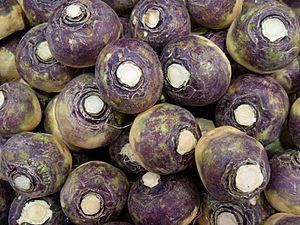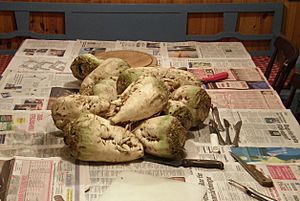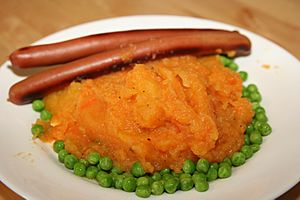Rutabaga facts for kids
Quick facts for kids Rutabaga |
|
|---|---|
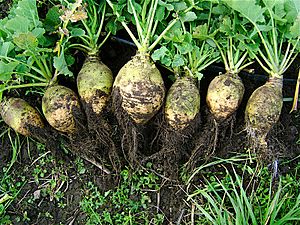
Rutabaga
|
|
| Species | Brassica napus |
| Cultivar group | Napobrassica Group |
Rutabaga is a root vegetable that looks a bit like a large turnip. It's also known as swede in places like the UK, Australia, and New Zealand. This vegetable is a type of Brassica napus, which is the same plant family as rapeseed. Other names for rutabaga include Swedish turnip or neep.
Rutabaga is a special plant because it's a hybrid of two other vegetables: cabbage (Brassica oleracea) and the turnip (Brassica rapa). People eat the roots of the rutabaga in many ways, and even the leaves can be cooked like other leafy greens. Farmers also use rutabagas to feed their livestock (farm animals) during winter or let them graze on the plants in fields during other seasons. In some parts of Scotland, Northern England, West England, and Ireland, there's a fun tradition of carving rutabaga roots into lanterns for Halloween.
Contents
What's in a Name?
Rutabaga has many different names depending on where you are in the world! In North America, it's usually called rutabaga. This name comes from the Swedish word rotabagge, which means "root lump" or "root bunch." In the United States, you might also hear it called Swedish turnip or yellow turnip.
In many Commonwealth countries, like England, Australia, and New Zealand, people call it swede. This name comes from "Swedish turnip." In parts of Northern England, Ireland, and Canada, it's often just called turnip. However, in most other places, "turnip" usually means the smaller, white turnip.
In Scotland, it's known as turnip, tumshie, or neep. The word neep comes from an old English word for turnip. In Sweden, its common name is kålrot, which means "cabbage root." Other European countries have similar names, like kålroe in Denmark and lanttu in Finland.
A Brief History of Rutabaga
The first time rutabaga was mentioned in a book was in 1620 by a Swiss scientist named Gaspard Bauhin. He wrote that it was growing wild in Sweden. Many people think rutabaga first came from Scandinavia, Finland, or Russia. Some studies suggest it was developed in both Finland and Sweden around the 16th century, by crossing turnips and cabbage.
Rutabaga arrived in England around 1750, possibly from Germany, and became more common by 1790. It came to North America in the early 1800s. By 1817, there were reports of rutabaga crops in Illinois.
During World War I and World War II, rutabaga became a very important food in Germany and France. It was often the only food available during times of shortage, especially in Germany during the "Turnip Winter" of 1916/17. Because of this, some older Germans have sad memories of eating rutabaga during those difficult times.
How Rutabaga is Eaten
Rutabaga is a versatile vegetable used in many dishes around the world.
Rutabaga in Finland

In Finland, rutabaga is a very popular ingredient. It's the main part of a traditional Christmas dish called lanttulaatikko, which is a delicious rutabaga casserole. This is one of three main casseroles served during Finnish Christmas meals.
Thinly sliced raw rutabaga is often served as a side salad in school and work lunches. Sometimes, raisins or pineapple are added to make it sweeter. Rutabaga is also a common ingredient in many Finnish soups, along with potatoes and carrots. These soups are often flavored with peppercorns and bay leaves.
Finns also roast, bake, boil, and grill rutabagas. Roasted root vegetables, including rutabaga, carrots, and potatoes, are a classic home-cooked meal. Karjalanpaisti is a slow-cooked stew that often includes rutabaga and meat. You can even find chips made from rutabagas, beetroots, and carrots in Finnish supermarkets!
In Sweden and Norway, rutabaga is mashed with potatoes and sometimes carrots. This mash is called rotmos in Sweden or kålrabistappe in Norway. It's often mixed with butter and broth or cream. In Norway, kålrabistappe is a must-have side dish for many special meals. In Sweden, rotmos is often eaten with cured and boiled ham hock and mustard.
Rutabaga in Europe
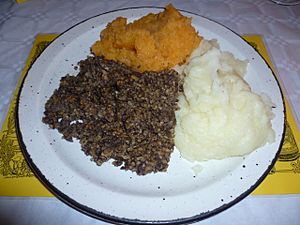
In the Netherlands, rutabaga is traditionally boiled and mashed. When mashed with potatoes and other vegetables, it becomes stamppot, a dish often served with smoked sausage.
In Scotland, rutabagas (called neeps) are boiled and mashed separately from potatoes (called tatties). They are then served together as "neeps and tatties" at a traditional Burns supper, usually with haggis. A dish called clapshot is made by mashing neeps with carrots or potatoes.
In England, swede is often boiled with carrots and served mashed or pureed with butter and pepper. The cooking water is sometimes used for soup or gravy. Swede is also an important vegetable in traditional Welsh lamb broth called cawl and Irish stew. It's also one of the four main ingredients in the famous pasty from Cornwall.
Rutabaga Around the World
In Canada, rutabagas are seen as a winter vegetable because they can be stored in a cool place for several months. They are mainly used as a side dish or as a filler in foods like mincemeat and Christmas cake.
In the United States, rutabagas are not as common, but you might find them in stews or casseroles. They can also be mashed with carrots or baked in a pasty. They are a frequent ingredient in the New England boiled dinner.
In Australia, swedes are used to add flavor to casseroles, stews, and soups.
Nutritional Value
| Nutritional value per 100 g (3.5 oz) | |
|---|---|
| Energy | 157 kJ (38 kcal) |
|
8.62 g
|
|
| Sugars | 4.46 g |
| Dietary fiber | 2.3 g |
|
0.16 g
|
|
|
Protein
|
1.08 g
|
| Vitamins | Quantity
%DV†
|
| Thiamine (B1) |
8%
0.09 mg |
| Riboflavin (B2) |
3%
0.04 mg |
| Niacin (B3) |
4%
0.7 mg |
| Pantothenic acid (B5) |
3%
0.16 mg |
| Vitamin B6 |
8%
0.1 mg |
| Folate (B9) |
5%
21 μg |
| Vitamin C |
30%
25 mg |
| Minerals | Quantity
%DV†
|
| Calcium |
4%
43 mg |
| Iron |
3%
0.44 mg |
| Magnesium |
6%
20 mg |
| Manganese |
6%
0.131 mg |
| Phosphorus |
8%
53 mg |
| Potassium |
10%
305 mg |
| Zinc |
3%
0.24 mg |
|
Link to USDA Database entry
|
|
| †Percentages estimated using US recommendations for adults. | |
Rutabaga is a good source of vitamin C. Just 100 grams of raw rutabaga contains about 25 milligrams of vitamin C, which is about 30% of the amount you need each day!
Other Uses for Rutabaga
Feeding Animals
Rutabaga roots and leaves have been used as a forage crop (food for animals) since the early 1800s. Farmers feed them to their livestock in winter, either by chopping them up or letting the animals eat them directly from the field.
Halloween Tradition
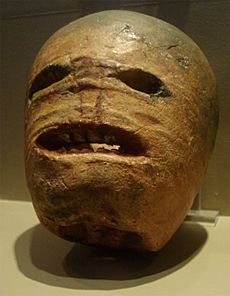
For a long time, people in Northern England, Ireland, and Scotland have carved turnips (which were often rutabagas) into lanterns. They used these lanterns to scare away harmful spirits. In the Middle Ages, groups of children would go around with masks and carved turnips called "tumshie heads." Today, these carved vegetables are often made to look spooky and placed in windows or on doorsteps at Halloween to keep evil spirits away.
In recent years, pumpkins have become more popular for carving in Europe. However, on the Isle of Man, people still carve turnip lanterns for Hop-tu-Naa (their version of Halloween). They light them with candles or flashlights and carry them from house to house, singing a special song and hoping for money or treats. The smell of burning turnip is a special part of this tradition!
Fun Festivals
Some towns even have festivals dedicated to rutabaga! In Ithaca, New York, there's an "International Rutabaga Curling Championship" held every year. The villages of Askov, Minnesota, and Cumberland, Wisconsin, both have an annual "rutabaga festival" in August.
See also
 In Spanish: Nabicol para niños
In Spanish: Nabicol para niños


